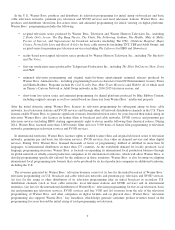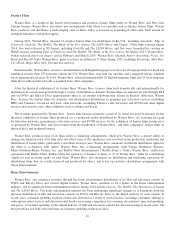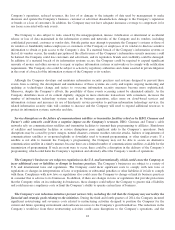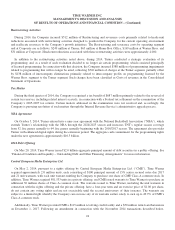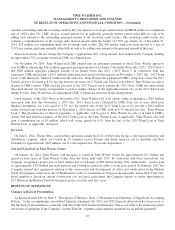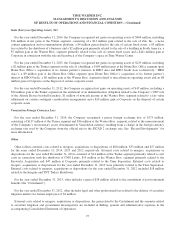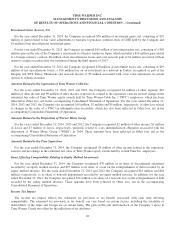Time Magazine 2014 Annual Report Download - page 34
Download and view the complete annual report
Please find page 34 of the 2014 Time Magazine annual report below. You can navigate through the pages in the report by either clicking on the pages listed below, or by using the keyword search tool below to find specific information within the annual report.Company’s operations, reduced revenues, the loss of or damage to the integrity of data used by management to make
decisions and operate the Company’s business, customer or advertiser dissatisfaction, damage to the Company’s reputation
or brands or a loss of customers. In addition, the Company may not have adequate insurance coverage to compensate it for
any losses associated with such events.
The Company is also subject to risks caused by the misappropriation, misuse, falsification or intentional or accidental
release or loss of data maintained in the information systems and networks of the Company and its vendors, including
confidential personnel, customer or vendor data. Outside parties may attempt to penetrate the Company’s systems or those of
its vendors or fraudulently induce employees or customers of the Company or employees of its vendors to disclose sensitive
information to obtain or gain access to the Company’s data. If a material breach of the Company’s information systems or
that of its vendors occurs, the market perception of the effectiveness of the Company’s information security measures could
be harmed, the Company could lose customers and advertisers, and its reputation, brands and credibility could be damaged.
In addition, if a material breach of its information systems occurs, the Company could be required to expend significant
amounts of money and other resources to repair or replace information systems or networks or to comply with notification
requirements. The Company also could be subject to actions by regulatory authorities and claims asserted in private litigation
in the event of a breach of the information systems of the Company or its vendors.
Although the Company develops and maintains information security practices and systems designed to prevent these
events from occurring, the development and maintenance of these systems are costly and require ongoing monitoring and
updating as technologies change and tactics to overcome information security measures become more sophisticated.
Moreover, despite the Company’s efforts, the possibility of these events occurring cannot be eliminated entirely. As the
Company distributes more of its content digitally, engages in more electronic transactions with consumers, increases the
number of information technology systems used in its business operations, relies more on cloud-based services and
information systems and increases its use of third-party service providers to perform information technology services, the
related information security risks will continue to increase and the Company will need to expend additional resources to
protect its information systems, networks and data.
Service disruptions or the failure of communications satellites or transmitter facilities relied on by HBO, Cinemax and
Turner’s cable networks could have a negative impact on the Company’s revenues. HBO, Cinemax and Turner’s cable
networks rely on communications satellites and transmitter facilities to transmit their programming to affiliates. Shutdowns
of satellites and transmitter facilities or service disruptions pose significant risks to the Company’s operations. Such
disruptions may be caused by power outages, natural disasters, extreme weather, terrorist attacks, failures or impairments of
communications satellites or on-ground uplinks or downlinks used to transmit programming, or other similar events. If a
satellite is not able to transmit the Company’s programming, the Company may not be able to secure an alternative
communication satellite in a timely manner, because there are a limited number of communications satellites available for the
transmission of programming. If such an event were to occur, there could be a disruption in the delivery of the Company’s
programming, which could harm the Company’s reputation and adversely affect the Company’s results of operations.
The Company’s businesses are subject to regulation in the U.S. and internationally, which could cause the Company to
incur additional costs or liabilities or disrupt its business practices. The Company’s businesses are subject to a variety of
U.S. and international laws and regulations. The Company could incur significant costs to comply with new laws or
regulations or changes in interpretations of laws or regulations or substantial penalties or other liabilities if it fails to comply
with them. Compliance with new laws or regulations also could cause the Company to change or limit its business practices
in a manner that is adverse to its businesses. In addition, if there are changes in laws or regulations that provide protections
that the Company relies on in conducting its businesses, these changes could subject the Company to greater risk of liability
and could increase compliance costs or limit the Company’s ability to operate certain lines of business.
The Company’s cost reduction initiatives present various risks, including the risk that the Company may not realize the
financial and strategic goals relating to the initiatives. During the third and fourth quarters of 2014, the Company incurred
significant restructuring and severance costs related to restructuring activities designed to position the Company for the
current and future operating environment and reallocate resources to the Company’s growth initiatives. The reductions in the
Company’s workforce from these restructuring activities could cause disruptions to the Company’s operations, and the
18



